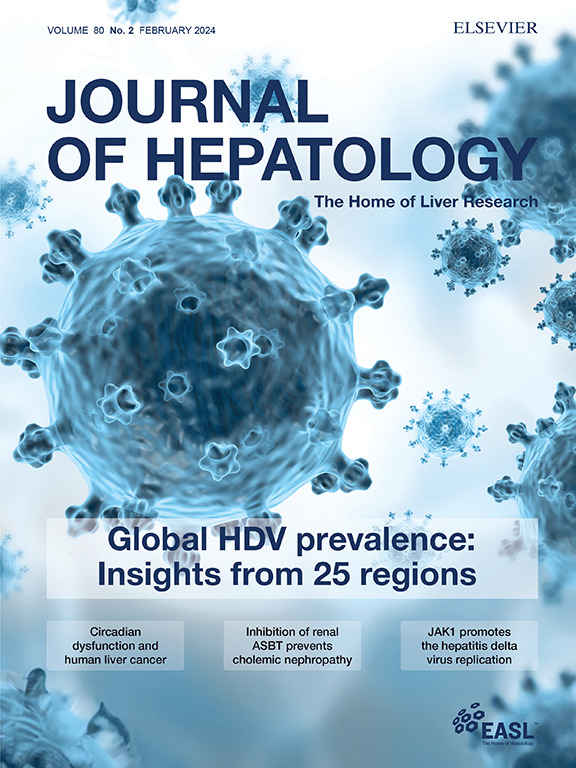Durvalumab plus chemotherapy in advanced biliary tract cancer: 3-year overall survival update from the phase III TOPAZ-1 study
IF 33
1区 医学
Q1 GASTROENTEROLOGY & HEPATOLOGY
引用次数: 0
Abstract
Background
At the TOPAZ-1 (NCT03875235) primary analysis, durvalumab plus gemcitabine and cisplatin (GemCis) significantly improved overall survival (OS) in advanced biliary tract cancer (aBTC). We report updated exploratory analyses of OS and safety, characterisation of extended long-term survivors (eLTS), and subsequent anticancer therapy (SAT) use.Methods
Participants with aBTC received durvalumab+GemCis or placebo+GemCis every 3 weeks (≤8 cycles), then durvalumab or placebo monotherapy every 4 weeks until progressive disease or other discontinuation criteria were met. OS and serious adverse events (SAEs) were assessed in the full analysis and safety analysis sets (FAS/SAS), respectively. eLTS outcomes were assessed (FAS participants alive ≥30 months after randomisation).Results
685 participants were randomised: durvalumab+GemCis (n = 341); placebo+GemCis (n = 344). After a median 41.3 (95% confidence interval [CI] 39.3–44.1) months’ follow-up in all participants, median OS (95% CI) for durvalumab+GemCis versus placebo+GemCis was 12.9 (11.6–14.1) versus 11.3 (10.1–12.5) months (hazard ratio, 0.74 [95% CI 0.63–0.87]); 36-month OS rate was 14.6% versus 6.9%, respectively. In participants who achieved disease control (566/685; 82.6%), the 36-month OS rate was higher for durvalumab+GemCis (17.0%) versus placebo+GemCis (7.6%). Overall, 12.8% were eLTS, with more eLTS in the durvalumab+GemCis (17.0%) versus placebo+GemCis (8.7%) arms; eLTS included all clinically relevant subgroups. Durvalumab+GemCis improved OS regardless of SAT use. In eLTS, SAEs were comparable between arms and less frequent than in the full SAS.Conclusions
Survival benefit and manageable safety continued with durvalumab+GemCis versus placebo+GemCis approximately 3 years after the last participant was randomised. All clinically relevant subgroups were represented in eLTS, supporting standard-of-care status for durvalumab+GemCis in aBTC.Lay summary
The TOPAZ-1 study found that treatment with durvalumab plus gemcitabine and cisplatin (chemotherapy, also known as GemCis), helped people with advanced biliary tract cancer (BTC) to live longer on average than those treated with a placebo plus GemCis. The latest results from TOPAZ-1 showed that these benefits continued for over 3 years in participants treated with durvalumab plus GemCis and side effects continued to be manageable. At an updated analysis, carried out 3 years after the last participant started the study, twice as many participants treated with durvalumab plus GemCis were alive compared to those treated with placebo plus GemCis. Results also showed that the positive effect of durvalumab plus GemCis compared with placebo plus GemCis was not affected by the use of other therapies some participants received after they finished the study treatment. These results continue to support durvalumab plus GemCis as a standard first-line treatment for people with advanced BTC.Clinical trial registration
ClinicalTrials.gov Identifier: NCT03875235; https://clinicaltrials.gov/study/NCT03875235

Durvalumab联合化疗治疗晚期胆道癌:来自III期TOPAZ-1研究的3年总生存期更新
在TOPAZ-1 (NCT03875235)的初步分析中,durvalumab联合吉西他滨和顺铂(GemCis)显著提高了晚期胆道癌(aBTC)的总生存期(OS)。我们报告了最新的OS和安全性的探索性分析,延长长期幸存者(eLTS)的特征,以及随后的抗癌治疗(SAT)的使用。方法aBTC患者每3周(≤8个周期)接受durvalumab+GemCis或安慰剂+GemCis治疗,然后每4周接受durvalumab或安慰剂单药治疗,直到疾病进展或满足其他停药标准。OS和严重不良事件(sae)分别在完整分析和安全分析集(FAS/SAS)中进行评估。评估eLTS结果(FAS参与者在随机分组后存活≥30个月)。685名参与者被随机分组:durvalumab+GemCis (n = 341);安慰剂+GemCis (n = 344)。在所有参与者中位41.3(95%可信区间[CI] 39.3-44.1)个月的随访后,durvalumab+GemCis与安慰剂+GemCis的中位OS (95% CI)分别为12.9(11.6-14.1)和11.3(10.1-12.5)个月(风险比,0.74 [95% CI 0.63-0.87]);36个月的OS率分别为14.6%和6.9%。在实现疾病控制的参与者中(566/685;82.6%), durvalumab+GemCis的36个月OS率(17.0%)高于安慰剂+GemCis(7.6%)。总体而言,12.8%为eLTS, durvalumab+GemCis组的eLTS(17.0%)高于安慰剂+GemCis组(8.7%);eLTS包括所有临床相关的亚组。Durvalumab+GemCis改善了OS,与SAT使用无关。在eLTS中,sae在各组之间具有可比性,且发生率低于完整SAS。结论:在最后一名参与者随机分组约3年后,durvalumab+GemCis与安慰剂+GemCis的生存获益和可管理的安全性继续存在。所有临床相关的亚组在eLTS中都有代表,支持durvalumab+GemCis在aBTC中的标准治疗状态。TOPAZ-1研究发现,durvalumab联合吉西他滨和顺铂(化疗,也称为GemCis)治疗可以帮助晚期胆道癌(BTC)患者比安慰剂联合GemCis治疗的患者平均寿命更长。来自TOPAZ-1的最新结果显示,在接受durvalumab加GemCis治疗的参与者中,这些益处持续了3年以上,副作用仍然是可控的。在最后一名参与者开始研究3年后进行的最新分析中,接受durvalumab加GemCis治疗的参与者的存活率是接受安慰剂加GemCis治疗的参与者的两倍。结果还显示,与安慰剂加GemCis相比,durvalumab加GemCis的积极作用不受一些参与者在完成研究治疗后接受的其他疗法的影响。这些结果继续支持durvalumab + GemCis作为晚期BTC患者的标准一线治疗。临床试验注册:clinicaltrials .gov标识符:NCT03875235;https://clinicaltrials.gov/study/NCT03875235
本文章由计算机程序翻译,如有差异,请以英文原文为准。
求助全文
约1分钟内获得全文
求助全文
来源期刊

Journal of Hepatology
医学-胃肠肝病学
CiteScore
46.10
自引率
4.30%
发文量
2325
审稿时长
30 days
期刊介绍:
The Journal of Hepatology is the official publication of the European Association for the Study of the Liver (EASL). It is dedicated to presenting clinical and basic research in the field of hepatology through original papers, reviews, case reports, and letters to the Editor. The Journal is published in English and may consider supplements that pass an editorial review.
 求助内容:
求助内容: 应助结果提醒方式:
应助结果提醒方式:


